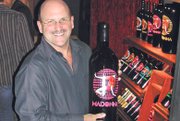Rock T-Shirt Goes Mainstream-and Gets Fashionable
When Dell Furano started in the concert merchandise business more than 30 years ago, some of the coolest musicians in the San Francisco Bay Area mocked the idea of selling T-shirts at their concerts.
It was pandering to their audience, they complained.
Man, have times changed.
The bohemian fear of selling out seems to have subsided.
Musicians are increasingly buying into the merchandise market today, and their timing is good.
The concert T-shirt, once a staple of high school parking lots, has become a high-fashion statement in the most exclusive retail neighborhoods. The explosion of rock merchandising in the last few years arrived just as sales of recorded music plummeted due to reasons ranging from a changing entertainment marketplace to piracy.
As the cachet of rock fashions have risen, opportunities for placing a band logo on a product—almost any product—have blossomed, said Furano, chief executive and owner of Signatures Network, a Beverly Hills, Calif.–based music merchandising and licensing company.
A recent example: On May 16, Signatures Network and the W Hotel co-hosted Madonna Gallerie, an exhibition of Madonna photographs and limited edition California wines with labels bearing pictures of Madonna and the logo of her upcoming Confessions Tour.
Furano’s other clients—such top classic rock stars as The Beatles, Grateful Dead, U2 and Bruce Springsteen, also have made lucrative branding deals, mostly in the realm of apparel.
The market, however, is wide open.
Kiss, a client of Signature Network, signed deals for products outside the mainstream of rock licensing. This year, the heavy-metal band lent their logo for fragrances and a cafeacute; in Florida.
But apparel seems to be the star of the rock licensing show.
Band logos are put on leather jackets, caps, sweaters and even premium denim. For example, Los Angeles–based premium denim manufacturer People’s Liberation last week announced a deal with Signatures Network to produce a denim line that uses the name of Motley Cruuml;e drummer Tommy Lee.
Straight out of California
Most of the action in the $1.4 billion rock-licensing market is in T-shirts. The capital of rock T-shirt manufacturing—perhaps 60 percent of the rock-licensing market, according to Furano— is California.
Some of the main players include Oakland, Calif.–based Cinder Block Inc., Bandmerch and Giant Merchandising of Commerce, Calif. Other companies making big business with rock T-shirts are Trunk Ltd., Lucky Jeans, Junk Food, Freeze, Dragonfly and Bioworld.
The entire range of retail seems to be game for the rock shirt. They vary from better contemporary stores such as M.Fredric to mall-based chains such as Hot Topic. Discount retailers such as Target and Wal-Mart, and department stores such as Macy’s are also in the game.
The market has grown considerably from its place more than 20 years ago when T-shirts were typically sold at concerts and specialty shops.
The long haul of the rock T-shirt mirrors Furano’s career. He started selling $4 Grateful Dead T-shirts in 1973 when he was chief of merchandising for Winterland Productions, a legendary concert promotion company in the San Francisco Bay Area.
Furano said the demand began to skyrocket in the 1980s, fueled by blockbuster concert tours such as Bruce Springsteen’s “Born in the USA,” U2’s “Joshua Tree” and Madonna’s “Like A Virgin.”
Currently, T-shirts retail between $25 and $45. Musicians’ merchandising contracts often command 45 to 50 percent of a concert’s merchandising gross. Furano estimated that goods sold at concerts might have earned $1 per concertgoer when his merchandising career began. Now, it’s $10 to $12 per head.
Fashion’s current craze for rock T-shirts started far from the din of rock arenas. Rather, these shirts are seen as an essential part of California’s premium look.
Connoisseurs of the concert T-shirt such as Los Angeles– based retailer Kelly Cole search for vintage rock T-shirts at flea markets and sell them at his Lo-Fi boutique for $50 to $1,000. His customers are collectors and the style conscious who want something to wear with their $150 jeans.
Cole said his clients rarely want a boxy T-shirt that years ago was a staple of concert merchandising but prefer form-fitting, thin garments.
“They’ll come in looking for something with the right texture and the right graphic,” Cole said. “As long as they’re not opposed to the band, the shirt is good.”
He said the deciding factor for the purchase often lies more with fashion than music. “A lot of people don’t even have knowledge of the bands,” Cole said. “It’s disappointing.”
The shirt’s association with rock music, however, is key, according to Jeannie Lee, co-owner of Satine, a Los Angeles–based contemporary luxury boutique and showroom.
“Rock ’n’ roll is cool,” Lee said, “and anything associated with the Rolling Stones or the Beatles is inherently cool. “It’s like how young people are still obsessed with James Dean and Audrey Hepburn. There’s still something iconic and classic about them.”
While demand for rock T-shirts often lies with the bands of the 1960s, ’70s and ’80s, T-shirt makers and licensers contend their business is not a nostalgia market.
Cinder Block specializes more in current rock bands such as Misfits and Radiohead. The business’s sales and staff volume quintupled in the past five years, according to company officials.
Licensers forecast growth to be strong, specifically in the fashion standard of the black concert tee.
But Furano said rockers often don’t want to overextend their brand potential, and often reject pitches from branded lines. Colombian singer Shakira rejected doing fragrances, he said. Beatles management company Apple Corp. and the families of the Fab Four rejected licensing sports coats and eyewear. Even Madonna, singer of the hit song “Material Girl,” has rejected jeans and a fashion line in the past.
Furano said many musicians are not interested in their fashion lines being one-hit wonders.
“A lot of celebrities look into branded lines,” he said. “But they know that if you successfully execute great fashion year after year, you got to be great.”






















